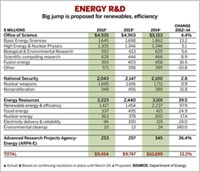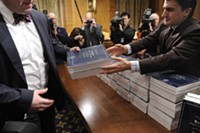Advertisement
Grab your lab coat. Let's get started
Welcome!
Welcome!
Create an account below to get 6 C&EN articles per month, receive newsletters and more - all free.
It seems this is your first time logging in online. Please enter the following information to continue.
As an ACS member you automatically get access to this site. All we need is few more details to create your reading experience.
Not you? Sign in with a different account.
Not you? Sign in with a different account.
ERROR 1
ERROR 1
ERROR 2
ERROR 2
ERROR 2
ERROR 2
ERROR 2
Password and Confirm password must match.
If you have an ACS member number, please enter it here so we can link this account to your membership. (optional)
ERROR 2
ACS values your privacy. By submitting your information, you are gaining access to C&EN and subscribing to our weekly newsletter. We use the information you provide to make your reading experience better, and we will never sell your data to third party members.
Policy
Investing In The Future
by Rudy Baum
February 18, 2008
| A version of this story appeared in
Volume 86, Issue 7
THIS WEEK'S ISSUE of C&EN focuses in part on our investment in the future. The cover story by Senior Correspondent Marc Reisch is our annual analysis of corporate R&D and capital spending. Another major story in the issue, a collective effort by C&EN's Government & Policy Department staff headed by Assistant Managing Editor Susan Morrissey, is our annual report on the proposed federal R&D budget.
The outlook is mixed. The chemical industry is increasing its investment in capital and R&D, albeit more slowly than in the past two years, Reisch reports. President George W. Bush's proposed budget, which stands almost no chance of passage, contains some worthwhile boosts in R&D spending but also reveals some unfortunate spending priorities.
The 17 chemical companies that responded to C&EN's annual survey plan an 8.6% rise in spending for new plants and equipment in 2008 to $8.8 billion, Reisch reports. The 14 firms that provided data on planned R&D spending project an increase of 6.0% over last year to a combined $2.8 billion.
Though the pace of the industry's capital and R&D spending growth has slowed, the 2008 figure of $9.9 billion for the 14 firms providing projections in both categories represents a collective high. The group's future-oriented spending hit a decade low of $5.8 billion five years ago, Reisch writes.
The Bush Administration's proposed budget for fiscal 2009 contains a record $147 billion for R&D, a 2.7% increase over what was appropriated for fiscal 2008. Of that, $29.4 billion would go to basic research, $27.0 billion to applied research, and $84.0 billion, or 57% of the entire R&D budget, to development. Development includes building and maintaining labs and the development of military weapons systems.
On the plus side, agencies that are part of the America Competes Act—the National Science Foundation, the Department of Energy's Office of Science, and the National Institute of Standards & Technology—are targeted to receive significant gains, C&EN's team reports.
NSF, for example, would see a 13% increase in funding, bringing its total to $6.9 billion. The largest increase in funds at NSF would go to the Mathematical & Physical Sciences Directorate (MPS), scheduled to grow by 20% to $1.4 billion; within MPS, the Chemistry Division gets the largest percentage gain at 26% to bring its budget to $245 million. After several years of languishing budgets for chemistry research at NSF, it is heartening to see these proposed increases.
DOE's Office of Science gets an 18.8% boost, but here is what seems to me to be an example of skewed priorities. Coal and nuclear energy receive, respectively, 26% (to $624 million) and 37% (to $1.4 billion) increases, while the energy efficiency and renewable energy program funding would be cut by 27% (to $1.3 billion).
This makes no sense. Nuclear energy will be an essential element in the coming decades in weaning ourselves from fossil fuels, so spending in this area is important. However, energy efficiency and renewable energy are also critical elements of this effort, and cuts in these areas are shortsighted. Meanwhile, most of the boost for coal R&D goes toward technologies to capture and sequester carbon dioxide, which I suspect is a complete boondoggle.
We have to learn how to run our advanced technological society while burning far less fossil fuel. When will politicians get that through their heads?
Another unwise element of the President's budget is the stagnant spending at the National Institutes of Health. It would be the sixth year that the agency's budget has fallen below the rate of biomedical inflation, estimated at 3.7% in 2008. After the prolonged effort to double NIH's budget in the 1990s, it makes no sense to allow inflation to erode those gains.
Looming over the entire budget—indeed, looming over the U.S. economy—is the war in Iraq. Regardless of how one perceives that effort, it has cost the U.S. between $600 billion and $1 trillion so far, with spending estimated at $2 billion to $3 billion per week. That is money that is not being spent on R&D, infrastructure, education, and a host of other investments in the nation's future.
Thanks for reading.
Views expressed on this page are those of the author and not necessarily those of ACS.




Join the conversation
Contact the reporter
Submit a Letter to the Editor for publication
Engage with us on Twitter